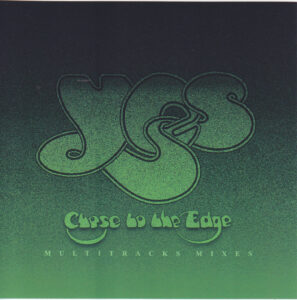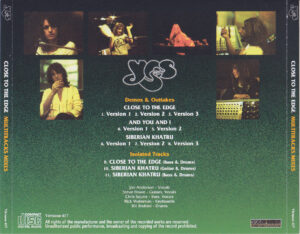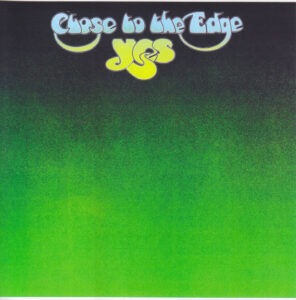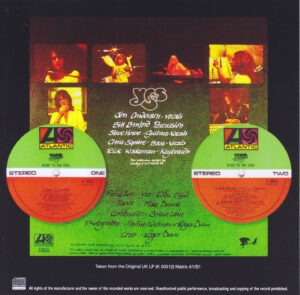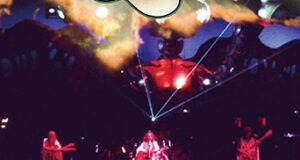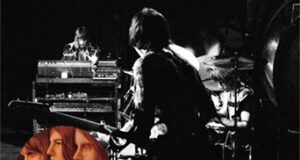Yes / Close To The Edge: Multitracks Mixes – 2nd Press / 1CD + 1Bonus CDR / Virtuoso
DEMOS & OUTTAKES plus Bonus CDR “CLOSE TO THE EDGE UK ORIGINAL LP:Matrix A1/B”
Beyond the framework of one band’s masterpiece, the super-masterpiece “Crisis” is even a treasure of one music genre “progressive rock”. A super-superb demo album approaching the backstage of the production will be reprinted and released on the 2nd press.
“Crisis” was truly a miraculous gift that made the goddess of music smile. The artwork is too simple, and all 3 songs are epic. While maintaining the beat feeling of a rock band to the last, it is a majestic song like a symphony. What is evolving rock, what is symphonic rock? I don’t think there is a musical work that is as easy to understand as Crisis and that embodies that ideal. Even now, nearly 50 years have passed, the brilliance has not faded, and it has become a huge existence that even the people who created YES cannot surpass.
I couldn’t help but write too many things now, but what I want to say is that “the studio where the production was in crisis was the scene where a miracle happened”. And this work is a studio album where you can experience the process in which the miracle was assembled.
Furthermore, what surpasses the finished version is the vividness. This depends on the take, but although processing such as effects has been applied, most are less than the finished version. In particular, John Anderson’s vocals are more “live”, and you can feel the “closeness” of guitars and drums ringing in your ears. [Highly complete demo that can be enjoyed as another version] ● Crisis (3 takes)
With such a sound, another aspect of the super-masterpiece “Kisei” is depicted. Now let’s talk about each song. First of all, three demos of the title track “Crisis” will appear. The completed version has a different length, “Crisis #1” is “3 minutes 21 seconds”, “Crisis #2” is “13 minutes 27 seconds”, and “Crisis #3” is also “3 minutes 21 seconds”.
“Crisis #1” starts with “The Solid Time Of Change”, but from there it’s a short arrangement that goes straight into the highlights. It’s like a single edit, but it’s not just short, it’s different for each take, and if the vocal melody is different, the densely layered performance is (partially) different. (Although it’s just an imaginary analogy) It’s like trying to make a normal size song from the intro and the most delicious part.
On behalf of him, “Crisis #2” is a long version that approaches the finished version (18 minutes and 41 seconds), but the ensemble is rougher. The performance itself is not rough, but a type like a rough mix. Not only is the Moog not overdubbed, there are significantly fewer choruses and effects, and the performance sound is exposed. And the performance and vocal take are also different. It’s not so simple as to call it a skeleton, but it’s a take that looks like you’re working out the composition of the big song before decorating it.
The following “Crisis #3” is again a short version of 3 minutes. The ensemble itself is quite close to the finished version, with a take that enhances the degree of perfection of “Crisis #1”. However, you can still see the sweetness of the claws with the vocals. Eddie Offord is said to have assembled a large song by cutting and pasting tape, but it may be one of those parts.
Doshi (2 takes)
“Doshi” also includes two takes with different lengths, “Doshi #1” is “10 minutes 57 seconds” and “Doshi #1” is “2 minutes 40 seconds”. First of all, “Comrade # 1” is the only take in this work that is longer than the completed version (9 minutes 59 seconds). I can’t help but expect a grander idea than the finished version, but the opposite world flows out. Although the basic structure of the song has not changed, there are clearly few decorations such as choruses, effects, and overdubs, and the finish is vivid. There is no 4 or 9 minute steel guitar. Also, the biggest surprise for the long factor is the ending. While the final version reprises the theme, this take reaches a denouement with a completely different melody. Although it feels like a little more stuffing is missing, this is impressive. It is the greatest hidden treasure in this work that makes you feel another possibility of the masterpiece.
“Doshi #2” is short, but has a steel guitar and is more complete. Maybe it was kneaded for each part.
● Siberian Katur (3 takes)
The last “Siberian Katur” is also a total of 3 takes: 1 main long version and 2 parts short versions. “Siberian #1” is “9 minutes 21 seconds”, “Siberian #2” is “2 minutes 20 seconds”, and “Siberian #3” is “2 minutes 6 seconds”. “Siberian #1” is a vivid take that starts with a count of “1, 2, 3, 4”. John’s scat “Doo Doo Doo …” in the 3-minute range is also very different (you can hear the voice of the studio momentarily), and the 7-minute scat “Da!” Is not included. The guitar cut in the chorus is loud, and the solo played on the harpsichord in the finished version is also an organ.
And more than that is the vividness of the whole. This article also touches on minor differences, but basically this work is not “locally different from the final version”. Every part is completely different the moment you listen to it. If the mix is rough and the rhythm section is raw, there are very few decorations, as if it was a studio live with only five people. This work contains vivid versions of all three songs, but this take is the best in terms of rawness.
“Siberian #2” is a short version that is close to the finished version. There are guitar solos and John’s scats, and the chorus and decorations are pretty well done. However, the effects are still rough, and it’s a version that seems to have entered the final stages of trial and error. The last “Siberian #3” is almost at the same stage, and may be the second half of “Siberian #2”.
Although the performance itself is the same as the finished version, the liveliness of only two instruments is outstanding, and the details of the performance, from slight bends to tom twirls, are super vivid. The outline of the song is also clear. Unlike the main demo, it is not something that can be enjoyed as music, but the fun of the performance that changes the expression with modulation etc. far surpasses the completed version. Above all, it is a take that can not bear the fun that each one of the parts that created the miracle is exposed.
This is a treasure collection of 11 takes and 76 minutes and 43 seconds. The sound quality is more like a studio album than a demo, and the music is perfect. And above all, it is a super-superb studio soundboard recording that details the process in which miracles piled up and formed the super masterpiece “crisis”. A historical piece with a different dimension from many demo albums. Please enjoy it with a permanent preservation press CD.
★ A super-superb studio album that approaches the behind-the-scenes production of the super-masterpiece “Kisei”. It is a sound board recording that recorded 3 takes of “crisis” in the middle of production, 2 takes of “comrade”, and 3 takes of “Siberian Cartur”, but the surprise is the quality. Every take is listened to and completely different from the finished version, but the sound itself is not at all inferior to the finished version. And each track surpasses the finished version even in its freshness. Most of the takes have no overdubs or effects, and the playing and vocals are partially different. In addition, a bonus take of the rhythm tracks of all three songs is included, allowing you to enjoy various different versions of “crisis”.
1バンドの最高傑作という枠を超え、1つの音楽ジャンル“プログレッシヴ・ロック”の至宝でさえある超名盤『危機』。その製作裏舞台に迫れる超極上デモ・アルバムが2ndプレスで復刻リリース決定です。
『危機』は、まさに音楽の女神が微笑んだ奇跡の賜でした。シンプルすぎるアートワークに、全3曲という大作主義。あくまでもロックバンドとしてのビート感を保持しながらもシンフォニーのような雄大壮麗な曲想。進化するロックとは、シンフォニック・ロックとは何物なのか。『危機』ほど分かりやすく、その理想像を体現した音楽作品はないでしょう。その輝きは50年近くが経とうとしている現在でも微塵も色あせることがなく、創り上げたYESの当事者達ですら超えることができない巨大な存在となっています。
思わず今さらすぎる事を書き連ねてしまいましたが、申し上げたいことは「危機の製作していたスタジオは、奇跡が起きた現場」だったという事。そして本作は、その奇跡が組み上げられていった過程を体験できるスタジオ・アルバムなのです。
【デモの次元を超えたサウンド・クオリティ】
味気なく言ってしまえば、本作は『危機』のデモ・トラック集。製作途中の「危機」を3テイク、「同志」を2テイク、「シベリアン・カートゥル」を3テイク収録したもので、いずれも完成版とは大きく異なる(さらに3テイクのボーナス・トラックも追加収録されていますが、それは後述します)。言わば、名画のスケッチのようなものです。しかし、現実に流れ出る音楽はそんな言葉で表現しきれるものではない。まず「デモ」と言って思い出されるものとはサウンドが違いすぎる。一聴して完成版とはまったく異なっていながら、サウンド・クオリティ自体は完成版にまったく劣っていない。2010年代の初頭に突如として登場した音源なのですが、ダビング痕などまるでなく、下手をすると後から加工された公式リマスター盤よりも鮮度が良いくらい。「デモ=音がショボイ」という固定概念を木っ端微塵に叩き壊す超極上のサウンドボード音源なのです。
さらに完成版を凌駕しているのは生々しさ。これはテイクにもよりますが、エフェクトなどの加工も施されてはいるものの、ほとんどが完成版よりも少ない。特にジョン・アンダーソンのヴォーカルはより「生声」であり、ギターやドラムも耳元で鳴っているような「近さ」を感じられるのです。
【別バージョンとして楽しめる完成度の高いデモ】
●危機(3テイク)
そんなサウンドで描かれるのは、超名盤『危機』の別の姿。ここからは各曲について触れていきましょう。まず登場するのはタイトル・トラック「危機」のデモ3種。完成版はそれぞれ尺が異なり、「危機#1」は“3分21秒”、「危機#2」は“13分27秒”、「危機#3」も“3分21秒”です。
「危機#1」は「The Solid Time Of Change」からスタートしますが、そこから一気にハイライトへ入る短尺アレンジ。まるでシングル・エディットのようですが、単に短いのではなくテイク毎異なり、ヴォーカル・メロディも違えば、緻密に重ねられていく演奏も(部分的に)違う。(あくまで想像上の喩えですが)まるでイントロと一番美味しいパートから普通サイズの曲を作ろうとしたかのようなテイクです。
代わっての「危機#2」は完成版(18分41秒)にも迫る長尺版ですが、アンサンブルはもっとラフ。演奏自体がラフなのではなく、ラフミックスのようなタイプ。モーグがオーバーダブされていないだけでなく、コーラスやエフェクトの類も大幅に少なく、演奏音が丸出し。そして、これまた演奏やヴォーカルのテイクが異なる。骨組みと呼ぶほどシンプルではないものの、飾り立てる前に大曲の構成を練っているようなテイクです。
続く「危機#3」は再び3分台の短尺バージョン。「危機#1」の完成度を高めたようなテイクで、アンサンブル自体はかなり完成版に近い。しかし、それでもヴォーカルの入りなどでまだツメの甘さが見える。エディ・オフォードはテープの切り貼りで大曲を組み上げていったとも言われていますが、そんなパーツの1つなのかも知れません。
●同志(2テイク)
「同志」も尺の異なる2テイクが収録されており、「同志#1」は“10分57秒”、「同志#1」は“2分40秒”です。まず「同志#1」ですが、これは本作で唯一、完成版(9分59秒)よりも長尺なテイク。思わず完成版よりも壮大な曲想を期待してしまいますが、流れ出るのは逆の世界。曲の基本構造は変わらないものの、コーラスやエフェクト、オーバーダブといった装飾は明らかに少なく、生々しい仕上がり。4分台や9分台のスティールギターもありません。また、長尺の要因にして一番の驚きはエンディング。完成版ではテーマがリプライズするのに対し、このテイクではまったく違うメロディで大団円を迎える。あとちょっとの詰めが足りない感じはするものの、これはこれで感動的。名曲の別の可能性を感じさせてくれる、本作でも最大級の秘宝です。
「同志#2」は、短尺ながらスティールギターも入って完成度が高まっている。もしかしたらパーツ毎に練り込んでいったのかも知れません。
●シベリアン・カートゥル(3テイク)
ラストの「シベリアン・カートゥル」もメインの長尺版1種とパーツ的な短尺版2種の計3テイク。「シベリアン#1」が“9分21秒”、「シベリアン#2」が“2分20秒”、「シベリアン#3」が“2分6秒”です。「シベリアン#1」は「1、2、3、4」のカウントから始まる生々しいテイク。3分台にあるジョンのスキャット「ドゥドゥドゥ……」も大きく異なっています(瞬間的にスタジオの話声?も聞こえます)し、7分台のスキャット「ダ!」も入っていない段階のもの。サビの部分のギターのカッティングがラウドですし、完成版ではハープシコードで弾かれるソロもオルガンです。
そして、それ以上なのが全体の生々しさ。本稿では細かい違いについても触れていますが、本作は基本的に「完成版と局所的に異なる」というものではありません。どのパートも聴いた瞬間にまるで違っている。ミックスもラフでリズム隊も生が丸出しなら装飾も極めて少なく、まるで5人だけのスタジオライヴかのよう。本作には3曲とも生々しいバージョンが収録されていますが、生っぽさではこのテイクが一番です。
「シベリアン#2」は短尺ながらグッと完成版に近づいたバージョン。ギターソロもジョンのスキャットも入っていますし、コーラスや装飾もかなり施されています。ただ、エフェクト類はまだまだラフで、試行錯誤の詰めに入ったようなバージョンです。ラストの「シベリアン#3」もほぼ同じような段階で、「シベリアン#2」の後半部分かも知れません。
【完成版マルチから抜き出された個別テイク】
そんなデモだけでもお宝ですが、本作ではプレス化に際して更なる『危機』のスタジオ・サウンドボードを追加収録しました。それはアルバム3曲の抜き出しトラック。「危機」と「シベリアン・カートゥル」はリズム隊(ベースとドラム)で、「同志」はギターとドラムのトラックだけのものです。
演奏そのものは完成版と同じながら楽器2つだけを抜き出した生々しさは絶大で、ちょっとしたベンドやタム回しにいたるまで演奏の微細部が超ビビッド。曲の骨子も丸わかりです。本編デモと違って音楽として楽しめるものではありませんが、転調等でガラッと表情の変わる演奏の面白さは完成版を遙かに凌ぐ。何より、奇跡を生み出していったパーツの1つひとつが丸出しになる面白さが堪えられないテイクです。
以上、全11テイク・76分43秒の秘宝集です。デモと言うよりはスタジオ・アルバムと呼びたいサウンドクオリティ、音楽作品としても完成度。そして何より、奇跡が積み重なって超名盤『危機』を形づくっていった過程も詳らかにする超極上のスタジオ・サウンドボード録音です。幾多のデモ・アルバムとは次元の異なる歴史的な1枚。永久保存プレスCDで存分にお楽しみください。
★超名盤『危機』の製作裏舞台に迫れる超極上スタジオ・アルバム。製作途中の「危機」を3テイク、「同志」を2テイク、「シベリアン・カートゥル」を3テイク収録したサウンドボード録音ですが、驚きなのはクオリティ。どのテイクも一聴して完成版とはまったく異なっていながら、サウンド自体は完成版にまったく劣っていない。そして、各トラックは生々しさでも完成版を凌駕。ほとんどのテイクがオーバーダブやエフェクトがなく、部分的に演奏やヴォーカルのテイクも異なっている。さらに全3曲のリズムトラックを抜き出したテイクもボーナス収録し、さまざまな別バージョンの『危機』が楽しめます。
(76:43)
DEMOS & OUTTAKES
Close To The Edge
1. Version 1
2. Version 2
3. Version 3
And You And I
4. Version 1
5. Version 2
Siberian Khatru
6. Version 1
7. Version 2
8. Version 3
ISOLATED TRACKS
9. Close To The Edge (Bass & Drums)
10. Siberian Khatru (Guitar & Drums)
11. Siberian Khatru (Bass & Drums)
Jon Anderson – Vocals
Steve Howe – Guitars, Vocals
Chris Squire – Bass, Vocals
Rick Wakeman – Keyboards
Bill Bruford – Drums
——————————————-
YES / CLOSE TO THE EDGE UK ORIGINAL LP: Matrix A1/B1 / 1CDR / Non Label
Taken from the Original UK LP (K 50012) Matrix A1/B1
click image To Enlarge
The main press CD is “crisis” where you can experience the growth process with the same quality as the official finished version. It is truly an underground masterpiece. Although it is “crisis” that came out in the world, there are various sound boards even in the completed version of “crisis”. Therefore, we have prepared a vertex sound board so that you can also experience the miracle of miracles.
The true identity of this work is the original UK edition of “Kiseki”. It is also directly digitized from “Matrix 1” which is the origin of the origin. I have introduced similar press boards and gift boards, but this work also carefully treats the (small) needle patch at the beginning, and it is one that you can experience “crisis” with the highest peak sound ever.
For those who have been particular about sound quality, no further explanation is necessary, so let’s continue the story for those who are not. “Matrix” is the number engraved on the mold for pressing the LP. I won’t go into details, but the lower the number, the earlier it is. Among them, the special one is “Mato 1” of the home country board (“A1” and “B1” in the title of this work mean Mato 1 for A side and B side). Literally, it is the first manufactured mold, but when “Mato 1” is manufactured, the staff involved in the record production, such as the artist himself, the producer, and the engineer, carefully check it. After that, the mold will be remade as many times as the album sells, but at that time there is no check. In other words, “Mato 1” is a sound that the parties who have listened to the master tape enough to get tired of at the studio stamped “This is the real thing”. For example, in KING CRIMSON’s “Crimson King’s Palace” box, I purposely put a digitized disc from the UK original first edition, but it’s such a special edition.
And this work is the “crisis” version. The sound is…it’s indescribable. It is truly a miraculous sound. Not only the three-dimensional effect that each musical tone weaves, but also the depth feeling that dwells in each sound is enormous, and the nature of how far from the rise to the disappearing moment. Speaking of the beauty of the ringing of hardware such as cymbals… Moreover, it is not just high-quality sound, but also has a “real feeling”. The digital remastered board that has been released many times also produces a three-dimensional effect with equalizing, but it is clearly different. The density of the analogue is wonderful, and the reality that you can feel the mass that does not exist in the original sound. Rather than “reproduce the real thing”, “this is the real thing”. Exactly, “crisis” flows out with the closest sound to the sound sucked into the master tape.
I couldn’t help but write a commentary on the main story, but “Crisis” is the culmination of history. It is a miracle of music history that will transcend even the very existence of the band “YES”. Listen to such rare works with “real sounds”. No matter how long the rock history is and how big the world is, is there a better music experience than this? This work is a piece that gives you such a luxurious moment. Together with the main 2nd press CD, which is an underground super-masterpiece, please enjoy the experience that permeates the abyss of your heart.
★奇跡の名盤『危機』が成長していく様を体験できる超極上デモ・アルバム『CLOSE TO THE EDGE MULTITRACKS MIXES』。2ndプレスの初回限定ナンバー入りステッカー付きに限り、至高サウンドの超名盤を味わえる『CLOSE TO THE EDGE UK ORIGINAL LP:Matrix A1/B1』が特別に付属致します。
YES – CLOSE TO THE EDGE UK ORIGINAL LP:Matrix A1/B1(Bonus CDR)
Taken from the Original UK LP (K 50012) Matrix A1/B1
本編プレスCDは、オフィシャルの完成版と変わらぬクオリティで成長過程を体験できる『危機』。まさにアンダーグラウンドの超名盤です。そうして世に出た『危機』ではありますが、完成版の『危機』にしても様々なサウンドの盤が存在しています。そこで、奇跡の中の奇跡も併せて体験して頂くべく、頂点サウンド盤もご用意しました。
そんな本作の正体とは、『危機』のオリジナルUK盤。それも原点の中の原点たる「マトリックス1」からダイレクトにデジタル化されたものなのです。同様のプレス盤やギフト盤もご紹介した事がありますが、本作はさらに冒頭部の(微少な)針パチも丁寧にトリートメントし、史上最高峰サウンドで『危機』を体験できる1枚なのです。
音質にこだわってこられた方にこれ以上の説明は不要でしょうから、そうでない方のために話を続けましょう。「マトリックス」とは、LPをプレスための金型い刻まれた番号。詳細は省きますが、この番号が若いほど初期のものとなります。その中で特別なのが本国盤の「マト1」です(本作のタイトルにある「A1」「B1」とは、A面用・B面用のマト1を意味します)。文字通り、最初に製造された金型なのですが、通常「マト1」が製造される際には、アーティスト自身やプロデューサー、エンジニアなど、レコード製作に関わったスタッフが入念にチェックを入れる。その後、アルバムが売れるほどに何度も金型を作りなおす事になるのですが、その際にはチェックは入らない。つまり、「マト1」とはスタジオ現場で飽きるほどマスター・テープを聴いてきた当事者達が「これこそ本物」と太鼓判を押したサウンド。例えば、KING CRIMSONの『クリムゾン・キングの宮殿』ボックスではわざわざU.K.オリジナル初回盤からデジタル化したディスクを入れた事もありましたが、それほどまでに特別な盤なのです。
そして、本作はその『危機』版。そのサウンドは………筆舌に尽くしがたい。まさに奇跡の音です。各楽音が織りなす立体感だけでなく、1音1音に宿る奥行き感も絶大で、立ち上がりから消えゆく刹那までどこまでの自然。シンバルなどの金物の鳴りの美しさと言ったら……。しかも、単に高音質なだけではなく「本物感」が宿っている。幾度となくリリースされてきたデジタル・リマスター盤もイコライジングで立体感を演出していますが、それとは明らかに異なる。アナログ由縁の密度が素晴らしく、本来音には存在しない質量まで感じる現実感。「本物を再現した」のではなく、「これこそが本物」。まさしく、マスター・テープに吸い込まれたサウンドに最も近いサウンドで『危機』が流れ出すのです。
本編の解説でも書かずにいられませんでしたが、『危機』こそ歴史上の至盤。バンド「YES」の存在そのものさえ超越するであろう音楽史の奇跡です。そんな希代の作品を「本物の音」で聴く。ロック史がいかに長く、世界が広いとしても、これ以上の音楽体験があるでしょうか。本作は、そんな贅沢なひとときをくれる1枚。アンダーグラウンドの超名盤たる本編2ndプレスCDと併せ、ぜひ心の深淵に染み渡る体験をお楽しみください。
(37:55)
1. Close To The Edge
2. And You And I
3. Siberian Khatru
Virtuoso 417
 GiGinJapan Artwork of Japanese CDs (mostly)
GiGinJapan Artwork of Japanese CDs (mostly) 